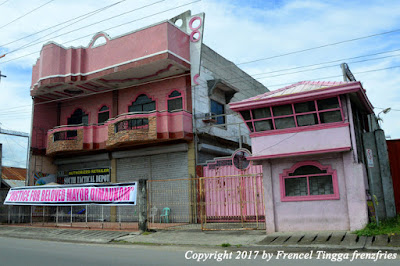The Grand Mosque in Cotabato costs a whooping US$48 million. It is also believed to be the grandest and among the largest mosques in the Philippines.
I think those are good reason enough to visit Cotabato City. Aside from the fact that it is the regional center of the Autonomous Region in Muslim Mindanao (ARMM).
It was an impulsive, spur of the moment trip, which started when I asked Manay (while we were having breakfast in Davao City) if she wants to see the mosque. She said “game” and asked “Hindi ba delikado dun?” I jokingly replied “Manay kung ano man mangyari sa atin dun, at least ikaw matanda ka na at na-enjoy mo na ang buhay, ako bata pa.” Hehe.
By midnight and after six hour of land travel, we were already in Cotabato. We checked in at Filipino Hotel, a budget hotel located at the heart of the city, adjacent to the town plaza and overlooking the Old City Hall, a striking century-old Malay-inspired building.
The morning after, we decided to rent a habal habal so we could visit the different landmarks of the city. Tanks, military cars, I think are a common sight in the area. A mayor was just recently assassinated. But quite honestly, I never felt that there was any peace and order problem in the city. In fact, it reminds me of my hometown, maybe just a little progressive.
The People’s Palace – the New City Hall houses the LGU and is a showcase of an ethno-modern Islamic architecture. A colourful giant signage of Cotabato City enhances the beauty of the whole complex.
Masjid Al-Salaamah is a green-motif worship place which according to our habal-habal driver was built by Robin Padilla for his Muslim brothers in Mindanao.
Jamiat Cotabato is a recently-opened, prestigious school for the Muslims. It specializes on Sharia, Tarbiyah Islamiah, Da’wah and special Arabic language. Some foreigners are studying in the school.
The Church of the Immaculate Conception of Tamontaka was built in 1872. It is one of the oldest Catholic churches in Mindanao and was declared a national historical landmark in 2004.
There’s a carinderia near the church. It was a good thing we spotted the eatery because we were able to taste the native delicacy of Cotabato – the pastil. At first I thought the pastil was the local version of my favorite Vjandep Pastel of Camiguin. I was wrong. It was actually a rice with pork toppings wrapped in banana leaf.
Just five minutes away from the carinderia is already the boundary of Cotabato City and Datu Odin Sinsuat of Maguindanao Province. We were able to visit the three known spots in the area.
MSU, the most popular state university in Mindanao, has a graduate school in Maguindanao that offers specialized courses on Islamic, and Peace and Development Studies.
The Al-Jamelah Weaving Center is a Peace Project and pasalubong center known for inaul, a Maguindanao handwoven silk fabric. Inaul is used as malong or sarong and worn as traditional dress by Maguindanaoans. At the center, we were able to see how the local women painstakingly weave the fabric into colourful and intricate design. That’s why the price tag of these inauls doesn’t come cheap.
The Lourdes Grotto is a large compound with retreat house, park and zoo. It showcases a replica of Our Lady of Lourdes Grotto in France.
The Masjid Dimaukom is the famed Pink Mosque in Datu Saudi Ampatuan, Maguindanao. Opened in 2014, the mosque's construction was financed by Mayor Samsodin Dimaukon. It also stands on a piece of land donated by his family. The mosque was painted pink because it is the favorite color of the Mayor and his wife, and the color symbolizes peace and love.
The Sultan Kudarat Provincial Capitol Building is a huge white Arabic-inspired structure with a big gold dome at the center and a giant statue of Sultan Kudarat (Muslim ruler and national hero) on the grounds. Located in the neighboring town of Isulan, Capitol houses the different provincial government offices.
And finally, the highlight of our trip – the Sultan Haji Hassanal Bolkiah Masjid or the Grand Mosque in Kalanganan. The mosque was named after the sultan of Brunei Darussalam, who generously funded its construction. The mosque located within a 15 hectare property, can accommodate more than a thousand Muslim worshippers. Luckily, we were the only tourists during our visit, thus we were able to run around the complex and fully enjoy the view and its surroundings minus the crowd. Even from afar, the mosque with its golden domes, minarets and white and cream walls, appears majestic.
There is so much more to see in Cotabato, even Maguindanao. I hope to be back one day. I love the peace signs I saw all over the place. I can contribute one. Make pastils, not war.
There are daily direct flights from Manila to Awang, Datu Odin Sinsuat, Maguindanao. From the airport, Cotabato City is around 20 minutes by car or jeepney. It can also be reached via a 6-hour land travel (bus or van) from Davao City or 4-hour land travel from GenSan.



































1 comment:
Hi there, I enjoy reading through your post. I like
to write a little comment to support you.
Post a Comment